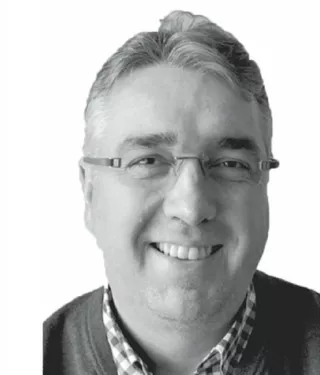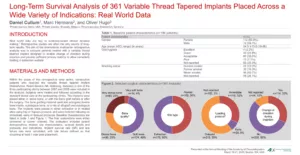
“This real-world data reinforces my confidence in NobelActive”
With almost thirty years’ experience as an implantologist and periodontist, Dr. Marc Hermans knows what makes an implant successful in the long term. He recently took part in a multi-center retrospective study into the long-term success of NobelActive implants.1 Here, he talks about his experience using NobelActive and what this real-world study data means to him.
Study summary
Long-term survival analysis of 361 variable thread tapered implants placed across a wide variety of indications: Real-world data
The aim of this international multi-center retrospective analysis was to evaluate patients treated with NobelActive in 2007–2008. Out of the 184 patients (361 implants) evaluated in this study, 122 (267 implants) were followed for longer than 1 year (mean follow-up, 7.9 years). Results:
– 95.9% long-term implant survival rate*
– 98.6% for implants with change of direction during insertion
– 94.3% for implants placed in soft bone
– 96.9% for immediate placement and immediate loading.
The study shows that the NobelActive implant, placed in a wide variety of indications and loading protocols, demonstrated high survival rates and can be considered a safe and viable option for partial and complete edentulism. Late failure analysis confirms the long-term survival, even after a change in direction of the implant during placement.
* For implants with long-term (>1 year) follow-up.
Interview with co-author, Dr. Hermans
Dr. Hermans, could you please tell us a little bit about your professional background?
I graduated in 1992 from the Université libre de Bruxelles (ULB) in Belgium. Before becoming a dentist I was actually an artist and a painter, but at a certain point, I decided to go in the direction of a more stable profession. I wanted to be a medical professional, and so dentistry felt like a great option.
In 1997, I opened my own dental practice, which focused on implantology and periodontics. I split my time between this and lecturing at the university until 2004.
When did you first begin using Nobel Biocare products?
I was first exposed to Nobel Biocare during dental school, since their implants were often used at ULB. I also began to conduct research on these products in 1993, and so from a very early point, I was interested in the difference between the data found through research and the actual clinical experiences. I’ve been using Nobel Biocare ever since.
What did you think about NobelActive when you first found out about it? What convinced you to start using it?
My first impression was that NobelActive was very convincing – it was a type of implant system I had been hoping for. In my previous research and clinical experience, I had seen that immediate loading was difficult to obtain systematically at the day of the surgery. But when I began working with NobelActive I gained much more confidence in being able to obtain the primary stability desired. I was fascinated by the way NobelActive had been designed, and this is why I began to use it almost immediately.
With other implants, there was, of course, the possibility for immediate placement. However, there was always a bit of stress involved as I often had to tell the patient that, after the surgery, the implant might not be stable and that we would have to perform delayed placement. With NobelActive, I quickly began achieving the stability I required for performing immediate loading with confidence.
Was it challenging when you first used NobelActive for implant treatment?
It might be my nature as a researcher, but after the necessary training on how to use NobelActive, I immediately wanted to challenge the capability of this new product in very difficult cases. I conducted tooth extractions with immediate implant placement in a range of situations and was very enthusiastic about the results.
NobelActive had a great impact on my career – in fact, it changed the way I work at my practice. Before using it, I was always somewhat nervous about conducting immediate tooth extractions and implant placements, whereas nowadays, achieving Immediate Function with an immediately placed implant – even in difficult circumstances such as soft bone – is standard at my practice.
How have your patients benefited from NobelActive?
Well, the obvious benefit of immediate implant placement is a shorter treatment time with fewer appointments, and I have found that my patients respond very positively to this.
Has NobelActive impacted your career as an implantologist?
Yes, because it enabled me to place implant immediately with the confidence of predictable and reliable results. NobelActive is an implant solution that I would definitely recommend to other clinicians.
What motivated you to undertake this study?
NobelActive was a big step forward in implant design when it was first introduced. As a researcher, I thought that it would be exciting and valuable to have real-world data on its long-term results. On examining my database, I found there were a good number of patients who received these implants 10 years ago, and that it would be very useful to know what the actual long-term survival rate was.
Sometimes clinicians tend to remember only the implant cases that suffer complications or failure, so it was important to get the objective data and not just a general feeling.
As a clinician, what does this real-world data mean to you?
For me, this real-world data reinforces my confidence in NobelActive. I have clear data that confirms, beyond doubt, that I can achieve long-term success with this implant, even in very demanding situations.
